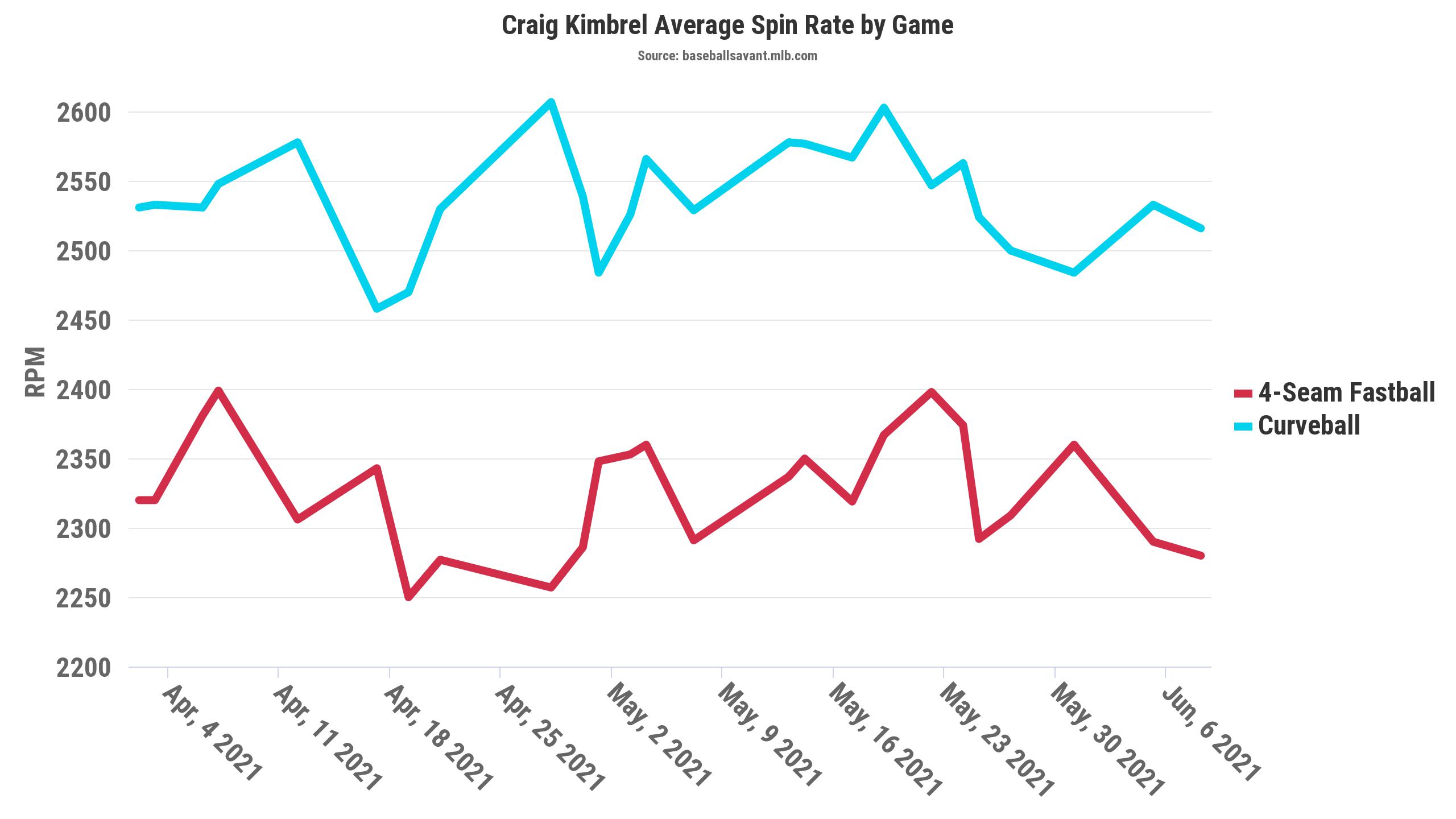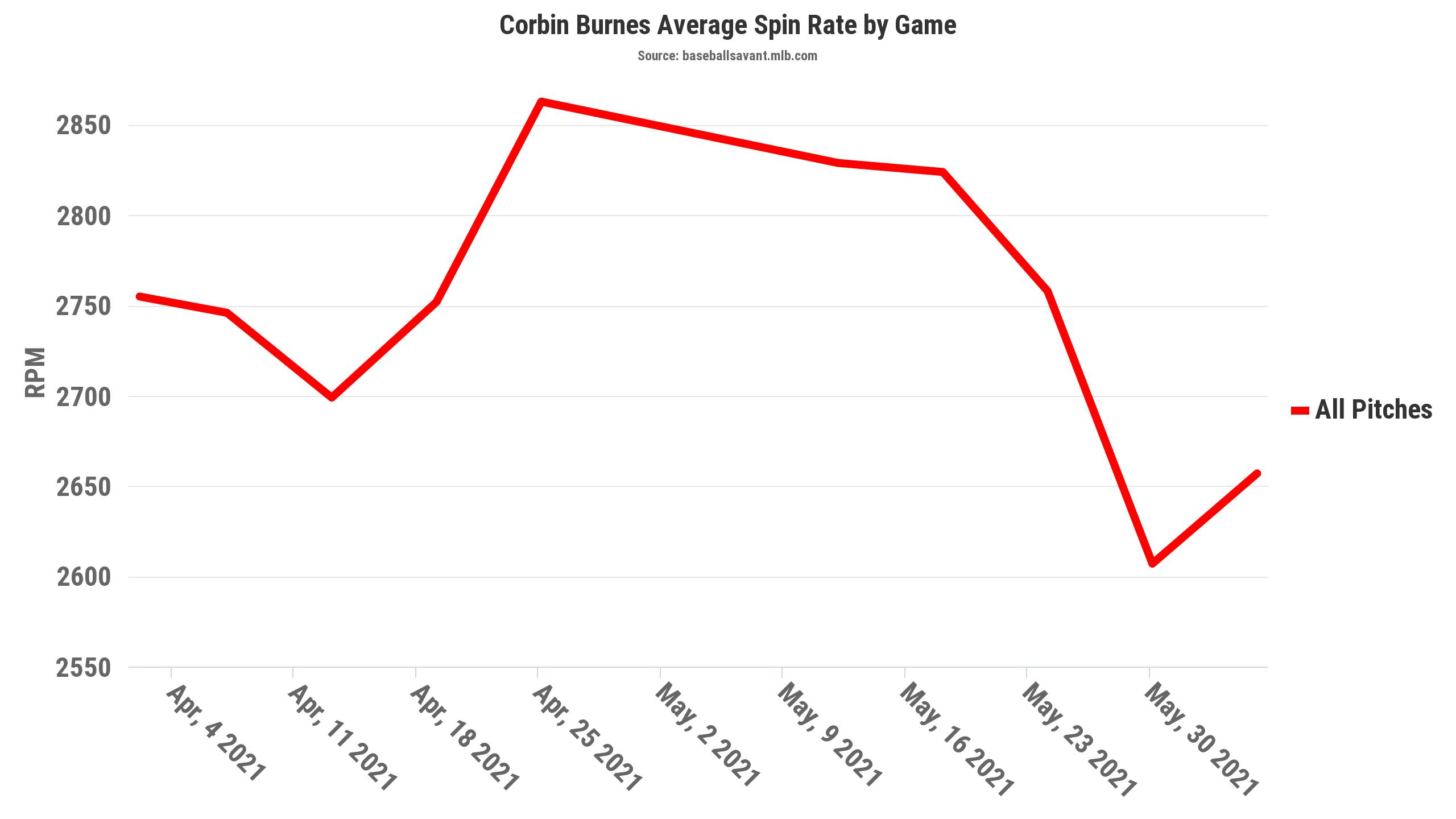
Are We Already Seeing Decrease in Spin Rates Since MLB’s Announced Crackdown on Sticky Stuff?
Pitchers have been using all manner of sticky substances to improve grip and enhance their stuff for as long as baseball has been around, but things have come to a head this season. As Buster Olney reported last week for ESPN, Major League Baseball is finalizing plans for stricter enforcement of its foreign-substance rules that will see all pitchers checked “repeatedly and randomly” rather than waiting for a team to lodge a complaint.
This stems largely from MLB’s offensive stagnation, but it’s also a matter of fans becoming more aware of pitchers’ dominance. Social media accounts like Pitching Ninja highlight the absolute filth being spun, making viewers wonder how anyone ever gets a hit. And “filth” isn’t just a metaphor any longer because the balls are being doctored up by some pretty serious adhesives.
As Brittany Ghiroli and Ken Rosenthal detailed in The Athletic, one NL team found that a ball saved from a rookie’s first hit was still sticky and replete with strands of glue hours after the game. It’s not just Trevor Bauer, who has spoken openly about the advantages of pine tar and other substances, or Gerrit Cole, a longtime Bauer nemesis dating back to their time as UCLA teammates, whose recent awkward response to a question about using Spider Tack had the baseball cognoscenti abuzz.
“I don’t quite know how to answer that, to be honest,” Cole said. “I mean, there are customs and practices that have been passed down from older players to younger players, from the last generation of players to this generation of players, and I think there are some things that are certainly out of bounds in that regard and I’ve stood pretty firm in terms of that, in terms of the communication between our peers and whatnot.”
Uh, sure.
Cole was among a group of players named back in January in Orange County Superior Court as part of a lawsuit Brian “Bubba” Harkins filed against his former employer. Harkins, a longtime clubhouse attendant with the Angels, was fired after the league learned he had become sought-after across the game for his special blend of rosin and pine tar. In addition to Cole, Bubba’s clientele included Justin Verlander, Edwin Jackson, Max Scherzer, Félix Hernández, Corey Kluber, Joba Chamberlain, Adam Wainwright, and Tyler Chatwood.
The list of pitchers using something for grip is much longer, as in pretty much every single pitcher ever. It might not all be as exotic as reducing Pepsi in a skillet until it turns to goo or experimenting with different mixtures of sunscreen and rosin to find the right tack for a given environment. One former MLB pitcher who played his home games in a domed stadium told me he used to dump a cup of water down his pant leg in order to wet his fingers during appearances because the pants were white and no one could tell.
Of course, the practice of doctoring the ball has been illegal all the while. The difficult part about actually trying to enforce the rules now is that the league is essentially admitting that the practice has been tacitly allowed for decades. As such, they need to provide a runway of what Olney reported was 10 days to two weeks to give players time to adjust.
Does that mean they’ll do away with any and all foreign substances? Doubtful. What about waiting until right when the stricter guidelines are adopted and then going cold turkey? Also no. Whether these guys have their preferred substance on a glove that best matches the color of the goo in question or on the bill of their cap, they’re going to need to clean that stuff off just to avoid getting popped for something they’re no longer doing.
Or maybe it’s just a matter of taking time to work substance-free for a while, like when Coach Winters made Lattimer kick the juice during ESU’s big season. We all know what happened there, or we do if we’ve seen The Program. Just like the media was responsible for cluing fans in to the widespread use of substances, it’s now being called upon to let players know that Cowboy Joe West and Co. are on the lookout.
As if West needed another reason to proactively insert himself into the action.
You have to wonder, then, whether we’ll start to see a dip in spin rate during this lead-up to the adoption of the stricter guidelines. After all, players are going to want to dial back or stop their use of sticky stuff before they are forced to. It’s probably too early to say anything really definitive about the effects of the pending changes, but let’s take a look at a few players and see if a pattern emerges.
Craig Kimbrel‘s overall spin rate decreased recently, but that’s mainly a result of going more to his four-seam. With an average of 2,323 rpm, the heater is more than 200 revolutions behind the curve. And as you can see in the chart below, the closer has experienced natural fluctuations in spin rate over the course of the season.

Rookie Tommy Nance has generated some big spin numbers on his breaking stuff and it would appear that he may have started to fall off, but it’s probably way too early to tell. While all of his pitches had much less spin than average in his last outing, he only threw 17 total and didn’t go to the slider at all. His four curveballs were at 2,787 rpm, the first time all season he’s been below 2,900, so maybe you can try to find something there.

Let’s shift away from the Cubs and take a look at Brandon Woodruff of the Brewers, who…Oh my God, look at that drop. In the interest of fairness, Woodruff’s most recent start came on June 5, the same day Olney’s report came out. He has also seen a sharp decrease in slider usage, which corresponds to that pitch’s drastic drop in spin. It went from averaging around 2,600 rpm through 10 starts to spinning 2,413 and 2,280 in his last two.

Even if it’s not entirely fair to pick on the Brewers, let’s take a look at Corbin Burnes for the hell of it. Would you look at that, he’s dropped off a bit as well. Once again, this could simply be a matter of pitch mix as Burnes was throwing his changeup nearly twice as much over the last two starts as he had in the previous two. His sinker has really dropped off as well, though, so it’s hard to say for sure.

I’ll let you draw your own conclusions about this next one, but I’ll note that each of Bauer’s pitches other than the curveball have fallen off lately. Like, big time.

Even if we’ve got some circumstantial evidence here to suggest that pitchers might be dialing back on use of foreign substances, it’s going to take a bigger sample to reveal the truth. The real key, then, will be seeing what happens to batting averages, home run counts, and other offensive metrics.
MLB is certainly hoping those numbers jump because it’ll mean they don’t have to keep answering questions about the real issues taking place between league HQ and Rawlings. I’m not sure where Rob Manfred found the time to become a urologist, but he’s been doctoring balls like nobody’s business for the past few years. First they added pop, then they tried to take it away. They changed density and seam height and all the while it just gets blamed on the manufacturer…that MLB owns.
Maybe the players aren’t actually the problem here and it’s really a matter of leadership. The best possible solution might be to standardize one or two grip-enhancing materials and call off the witch hunt. While I know that would still leave the door open to breaking the rules, it would set a better baseline and make penalties more plausible.
Regardless of what happens, I fully expect MLB to muck it up.

